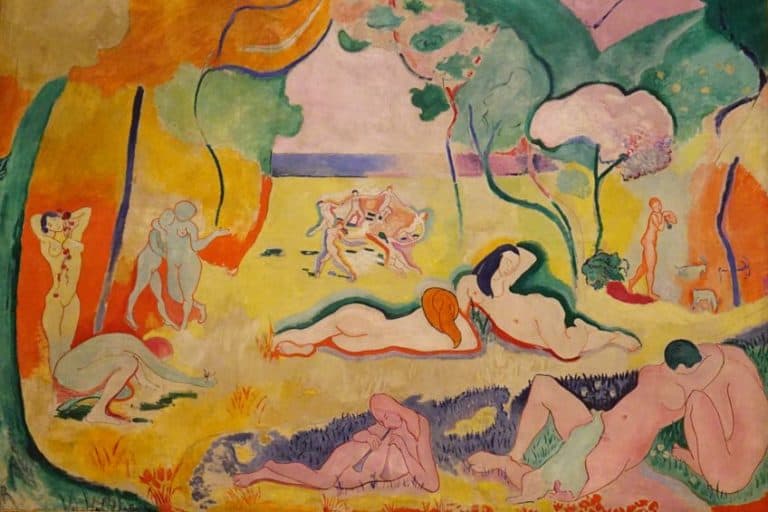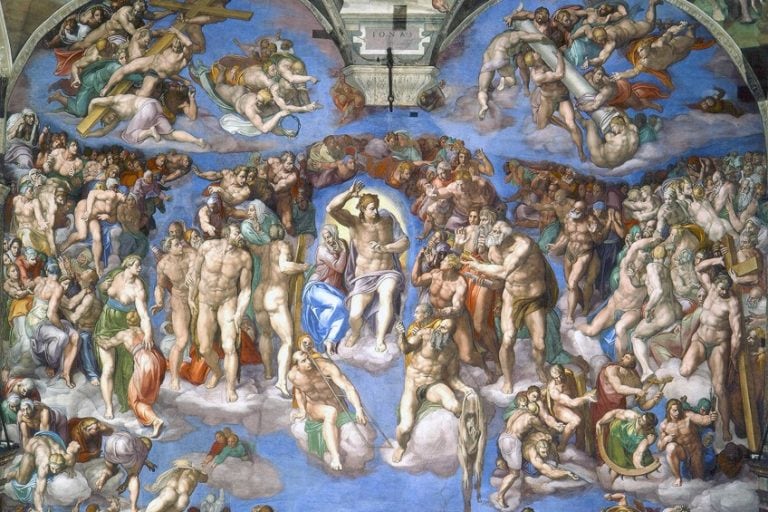Famous Renaissance Portraits – Faces of the Age of Humanism
The Renaissance period is recognized for its fervent artistic contributions to European history. A period that constituted countless exceptional artworks, from the likes of Leonardo da Vinci’s Mona Lisa to the Creation of Adam by Michelangelo. The Renaissance movement influenced subsequent movements and significantly inspired the development of art. In this article, we will be exploring the 10 most famous Renaissance portraits that were made between the 15th and 17th centuries.
Table of Contents
- 1 Portraits of the Renaissance
- 2 10 Most Famous Renaissance Portraits
- 2.1 Man in a Red Turban (1433) by Jan van Eyck
- 2.2 The Arnolfini Portrait (1434) by Jan van Eyck
- 2.3 Portrait of a Woman (c. 1435) by Robert Campin
- 2.4 Portrait of a Man and Woman at a Casement (c. 1435 – 1440) by Filippo Lippi
- 2.5 Portrait of a Young Girl (c. 1465 – 1470) by Petrus Christus
- 2.6 Mona Lisa (c. 1503 – 1506) by Leonardo da Vinci
- 2.7 Portrait of a Young Man (c. 1517 – 1518) by Andrea del Sarto
- 2.8 Self-Portrait (1548) by Caterina van Hemessen
- 2.9 Self-Portrait with Bernardino Campi (c. 1559) by Sofonisba Anguissola
- 2.10 Portrait of a Noble Woman (c. 1580) by Lavinia Fontana
- 3 Frequently Asked Questions
Portraits of the Renaissance
The Renaissance movement that spanned the 14th to 17th century in Europe focused on realism with its depictions, as it shifted from the Medieval period’s abstract forms. Renaissance art portraits were presenting people in their true form and reflected the development of the Humanist movement.
The artworks were not particularly extravagant, in fact, the backgrounds of most Renaissance portraits were quite plain. The subject became the focus of the painting. Artists would paint realistic representations of the people who posed for them, not simply recording their features but presenting a vivid depiction of the person before them.
It was during the Renaissance period that we saw the introduction of oil painting, which eventually became the standard for artists all over. This was in contrast to using tempera paint, which had been the previous artistic standard.
Previously portraits existed as part of larger compositions such as biblical or historical narratives, then it was during the 15th century that Renaissance art portraits came to fruition. Although Renaissance portrait paintings often depicted people that were of a higher social status, it was during this movement that for the first time in history essentially anyone could get a portrait of themselves done– as long as they could pay for it.
10 Most Famous Renaissance Portraits
Portraiture prospered under the rise of the Humanist movement during the Renaissance period. This reestablished the Ancient Classical fascination with human affairs and highlighted the development of the individual, with portrayals of distinctive likeness. There was a greater focus on accurately portraying human figures. Artists were preoccupied with realism and detailing costumes in their artworks. The resurgence of portraiture during the Renaissance led to the abundant artistic contributions that continue to be celebrated today. Here is our list of the 10 most famous Renaissance portraits.
Man in a Red Turban (1433) by Jan van Eyck
| Artist | Jan van Eyck |
| Date Painted | 1433 |
| Medium | Oil on panel |
| Dimensions | 26 cm x 19 cm |
| Where It Is Currently Housed | The National Gallery, London, England |
Jan van Eyck has been recognized, by some scholars, as the pioneer of the modern portrait because of his portrayal of Man in a Red Turban. It has been suggested that the enigmatic painting is a self-portrait of the famed artist, which represented a new genre. Among the Renaissance’s famous portrait paintings, van Eyck’s innovative positioning of the subject’s posture is considered one of the first examples of the three-quarter view.
The subject’s gaze is directed at the viewer, which proposes van Eyck’s targeted focus as he created his own image.

The genre of the self-portrait, innovated during the Renaissance by the man himself, showcased the artist’s style and talents. The subject’s flamboyant red turban against the dark background creates a striking contrast. If you look closely, you will note the incredible detail of the vivid highlights where the folds of the material catch the light and the dark shadows in the creases– these were very characteristic of van Eyck’s artistic style.
Jan van Eyck was able to achieve an outstandingly intricate degree of realism that was previously unknown to the art of Renaissance portrait paintings.
His rendering of human flesh had such a distinct quality of naturalism, so much so that it appeared as if he had fashioned a new artistic medium. Van Eyck was credited with the invention of oil painting by the art historian and Florentine painter Giorgio Vasari from the 16th century; this myth was carried into the 19th century. Although this myth was busted, he has since been coined the “Father of Oil Painting.”
The Arnolfini Portrait (1434) by Jan van Eyck
| Artist | Jan van Eyck |
| Date Painted | 1434 |
| Medium | Oil on oak panel |
| Dimensions | 82.2 cm x 60 cm |
| Where It Is Currently Housed | The National Gallery, London, England |
Another painting by the revered Jan van Eyck, as his scrupulous work was so greatly admired, is The Arnolfini Portrait, which is widely regarded as one of the most intriguing paintings in the history of European art. It is suggested that Jan van Eyck’s double portrait portrays Giovanni di Nicolao di Arnolfini, who was an Italian merchant, and his wife Costanza.
As one of the most famous Renaissance portraits, van Eyck’s painting is by no means simple but is deliberately calculated to convey various messages on behalf of its subjects.

Van Eyck carefully selected each object that he included in The Arnolfini Portrait to establish the couple’s social status and wealth, without mimicking that of the aristocracy. The male subject, Giovanni, has his hand raised seemingly in greeting. Amazingly, on the back wall between the two subjects, we see a convex mirror that shows two men entering the room, of which one has his arm raised.
The question remains, could the man in the mirror be van Eyck himself, being tended to by his servant? Directly above it, you will see van Eyck’s signature.
If you look closely, the painting reveals its incredible level of detail, demonstrating van Eyck’s masterful skills. Take note of the oranges to the left of Giovanni, they reflect the polished wood of the casement. Along with the beads that hang by the bed, they cast both reflections and shadows on the wall behind. Jan van Eyck exploited oil painting and the various techniques the medium permitted, which aided his ability to depict figures and objects in meticulous detail and in deep, full color.
Portrait of a Woman (c. 1435) by Robert Campin
| Artist | Robert Campin |
| Date Painted | c. 1435 |
| Medium | Oil with egg tempera on oak |
| Dimensions | 40.6 cm x 28.1 cm |
| Where It Is Currently Housed | The National Gallery, London, England |
Coined the “Master of Flémalle”, Flemish artist Robert Campin was one of the earliest masters and leaders of Flemish painting. Campin’s Portrait of a Woman (c. 1435) forms part of a pair of striking portraits titled A Man and a Woman, which are assumed to have formed the wings of a diptych that has since been dismantled. This was indicated by the marbled reverse side of each painting, suggesting that they were not meant to be hung against a wall.
The portraits that form “A Man and a Woman” are thought to be of a married couple.

Portrait of a Woman is particularly interesting; Campin’s artistic composition places her left eye in the center of the painting which allows her to assume a dominating position in the eyes of the viewer and of the pictorial space.
The colors Campin used were quite muted; predominantly white, black, and brown, yet he was still able to convey her optimistic and forceful personality.
The subject’s skin is smooth, and her bright eyes are wide open. Her eyes have an upwards curve in the corners, this is mimicked and amplified by the curves and folds of her headdress. The background is completely featureless.
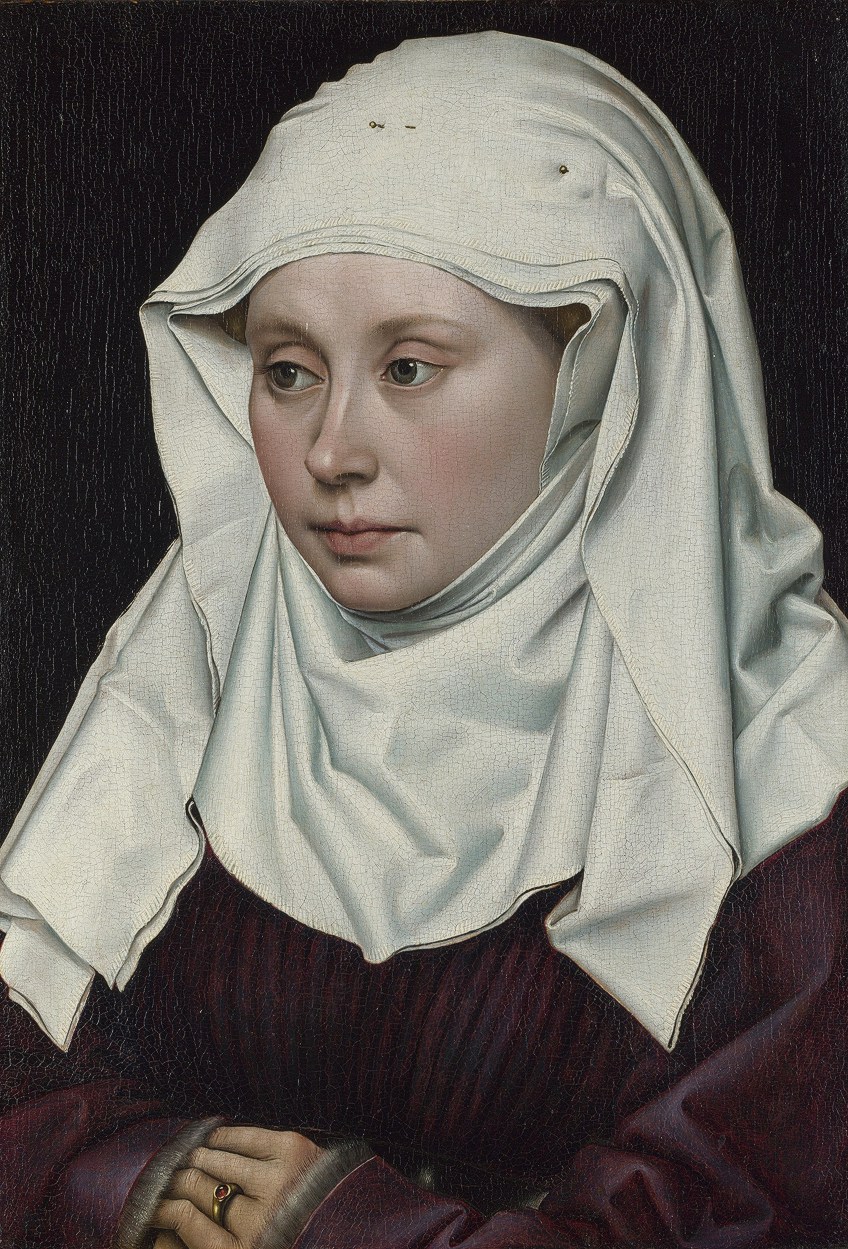
Setting the subject against the solid black backdrop makes her appear three-dimensional and life-like. She is well-dressed, but her clothes are not excessively rich, suggesting that the couple were affluent townsfolk. Although Campin’s work is fairly documented given his successful career, none of his work was dated or signed so the certainty with which these are his works is not exact. The painting’s attribution to Campin is on the basis of stylistic grounds.
Portrait of a Man and Woman at a Casement (c. 1435 – 1440) by Filippo Lippi
| Artist | Filippo Lippi |
| Date Painted | c. 1435 – 1440 |
| Medium | Tempera |
| Dimensions | 64 cm x 42 cm |
| Where It Is Currently Housed | The Metropolitan Museum of Art, New York, the United States |
In terms of Italian Renaissance portraits, Filippo Lippi’s Portrait of a Man and Woman at a Casement was very innovative for its time. The painting demonstrates the typical style of portraiture from the early Renaissance with its portrayal of the profile of the subject– it reflected Classical antiquity’s revival. Portrait of a Man and Woman at a Casement is the earliest example that we have of the double portrait from Italy that has survived.
When a portrait featured the profile of a subject, the artist’s ability to depict the subject’s facial expressions was limited.
Therefore, the artist would adapt by using symbolism as a representation of the subject’s characteristics. In Lippi’s Portrait of a Man and Woman at a Casement, he depicted his subject with pale skin, adorned in expensive garments to represent her purity and wealth. Lippi’s depiction of her beauty signified her virtue. The subjects are thought to be Angiola di Bernardo Sapiti and Lorenzo di Ranieri Scolari who married in 1439.
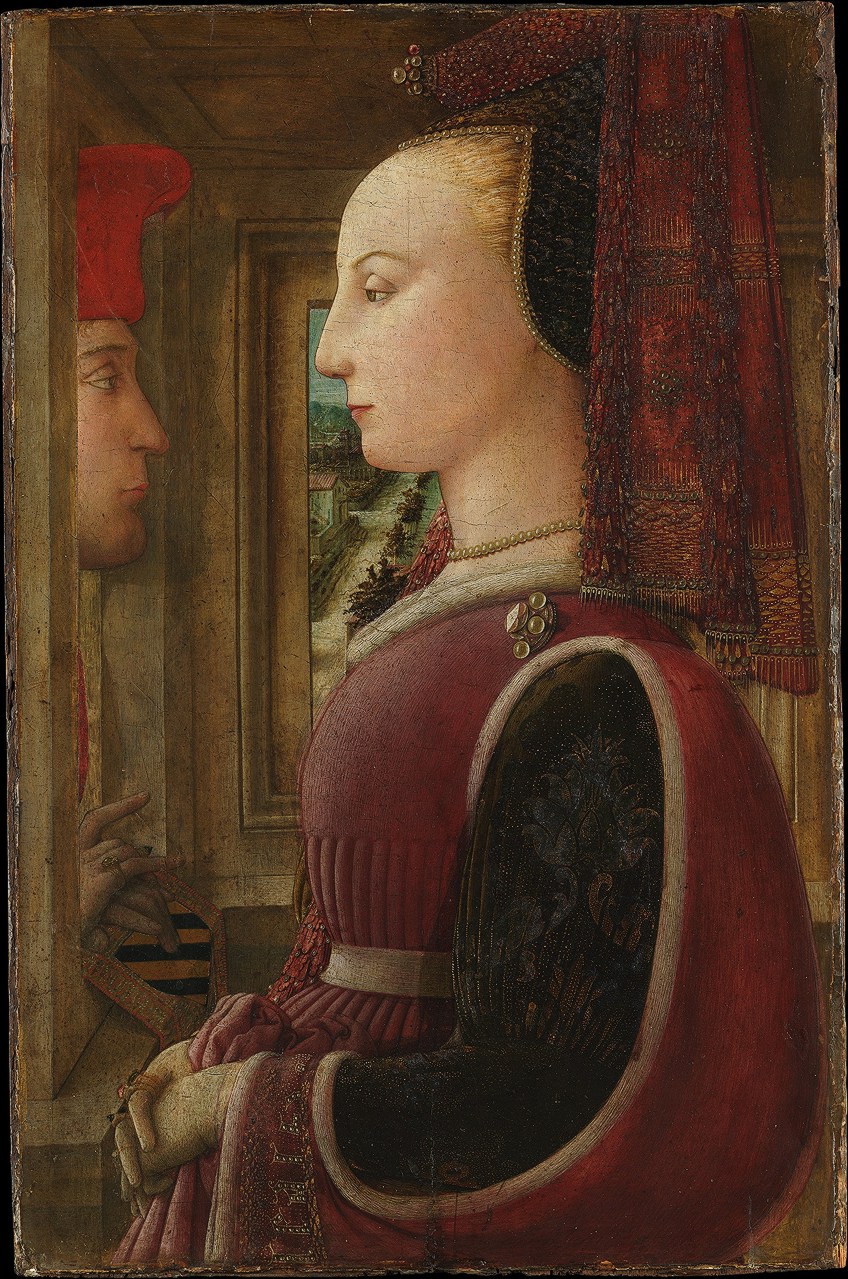
Lippi’s Renaissance-style portrait shows the subject in a domestic setting, in fact, it is the earliest example we have of a portrait where the subject is in a domestic setting with a view that reveals a landscape. It was likely one of the first wedding portraits.
The subjects’ eyes do not meet, as an averted gaze was a sign of modesty.
Marriage meant that the woman would become part of the husband’s household, as demonstrated by not only the composition of Lippi’s Renaissance-style portrait but also the inclusion of the Scolari coat of arms that Lorenzo is holding onto. The motto that is embroidered on Angiola’s sleeve, lealta, means “loyalty”.
Lippi skillfully incorporated topographical elements into his paintings, as can be seen in the window behind Angiola. It is as if he was documenting the possessions of the Scolari family, which included property as seen by the landscape, fine jewelry, and a virtuous wife. Portrait of a Man and Woman at a Casement was a very influential piece of artwork for the Italian Renaissance portraits that followed. Lippi’s genius was recognized in his mastery of compositions, coloring, and ornate detailing.
Portrait of a Young Girl (c. 1465 – 1470) by Petrus Christus
| Artist | Petrus Christus |
| Date Painted | c. 1465 – 1470 |
| Medium | Oil on oak |
| Dimensions | 70.29 cm x 22.5 cm |
| Where It Is Currently Housed | Gemäldegalerie, Berlin, Germany |
Petrus Christus was an Early Netherlandish painter and he produced what is widely considered as one of the most magnificent Northern Renaissance portrait paintings, Portrait of a Young Girl. As far as Renaissance famous portraits, Portrait of Young Girl signified a major stylistic advancement in contemporary portraiture.
The impassive sitter looks directly at the viewer with an enigmatic gaze, charming yet seemingly fragile, she is set in an unpretentious almost three-dimensional setting that allows her complex expression to dominate the frame.
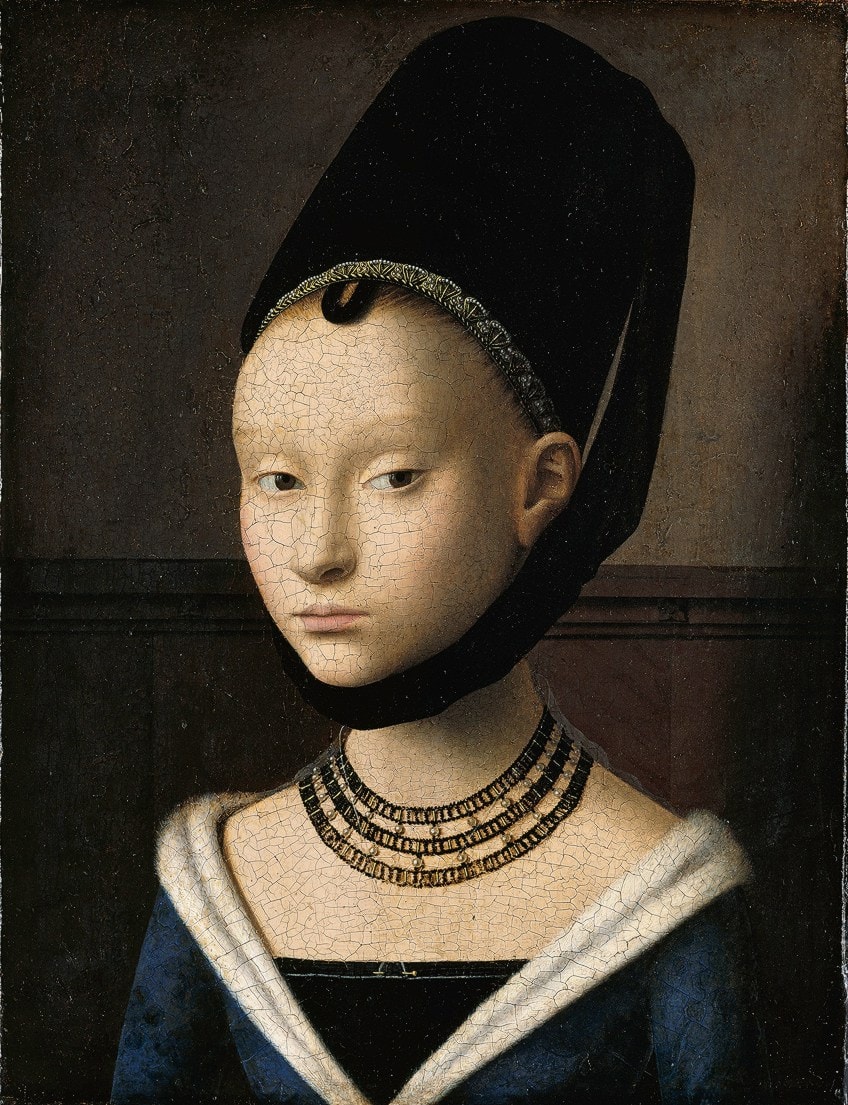
Christus broke away from tradition as he incorporated a realistic airy background that could have easily been the girl’s home, instead of using the traditional dark background. The young girl is wearing expensive jewelry and clothing, with a sense of poise that proposes her nobility. Her captivating gaze is highlighted by the subtle misalignment of her eyes, framed by her faintly plucked eyebrows.
It was relatively unprecedented for the subject of a painting to acknowledge her audience, even in Italian Renaissance portraits, which some scholars described as unnerving.
Christus’ portrayal of the young girl, with her opalescent skin and intense stare in his Portrait of a Young Girl, was exceedingly influential in the decades that followed its completion and was considered emblematic for subsequent Renaissance famous portrait paintings. Although very little is known about the identity of the sitter, her illuminating presence and distinct beauty set this work of art apart from its counterparts. Portrait of a Young Girl is a rare marvel that makes up Christus’ masterpiece.
Mona Lisa (c. 1503 – 1506) by Leonardo da Vinci
| Artist | Leonardo da Vinci |
| Date Painted | c. 1503 – 1506 |
| Medium | Oil on poplar panel |
| Dimensions | 77 cm x 53 cm |
| Where It Is Currently Housed | Louvre, Paris, France |
What has come to be known as the most famous painting in the world, of course, we have to acknowledge the Mona Lisa. Francesco Del Giocondo commissioned Leonardo da Vinci’s masterpiece of his wife, Lisa Gherardini. The Mona Lisa is recognized as one of the most prized portraits to come out of the Renaissance and is arguably one of the most exquisite examples of Renaissance art portraits.
Despite its value and eminence, much like Leonardo da Vinci’s other works, this painting was neither dated nor signed.
The subject sits elegantly in a chair with her chest and face turned to the viewer. The posture she holds is derived from the pyramid composition of the sitting Madonna. There is a sense of connection that you feel as the viewer looking into the eyes of the Mona Lisa. Yet, the somewhat protective placement of her arms and the armrest on which they sit distance her from you as the viewer.
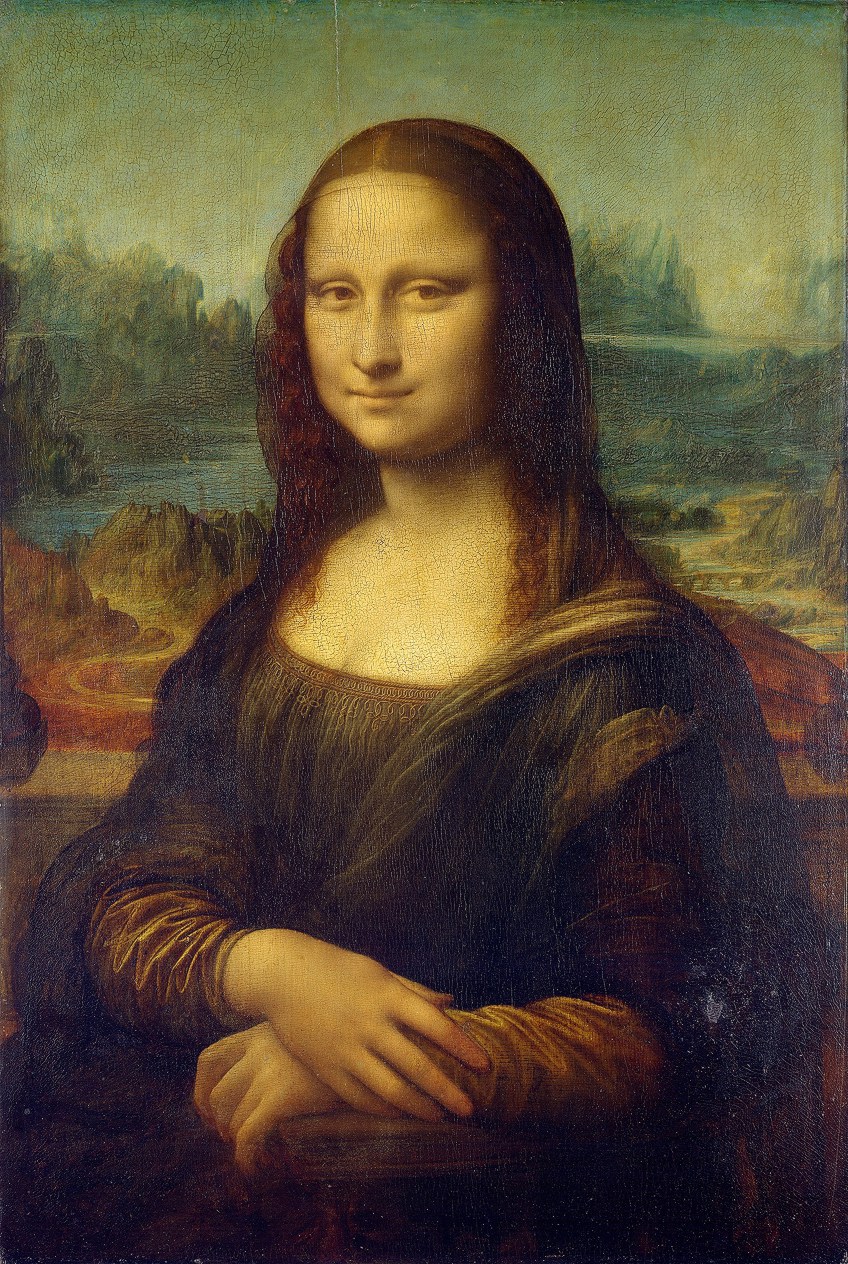
The muted color scheme: da Vinci’s mastery of sfumato, the painting technique where tones or colors practically melt into one another because they are blended in such a subtle manner; and the painting’s composition lend to the impression of serenity. According to da Vinci’s biography, written by Giorgio Vasari, the enigmatic smile that the Mona Lisa is known for came from Lisa Gherardini’s amusement at the troubadours and musicians that the artist had hired in an attempt to keep her entertained.
Leonardo da Vinci procrastinated over the painting; it is speculated that he continued working on it until 1517.
Namely, the placement of the subject’s hands took quite some consideration, but this was not in vain as many connoisseurs regard them almost as highly as the face. The contrast between her restful, elegant hands that have an almost lifeless quality, with her trace of a smile and her mesmerizing gaze, make it seem as if they belong to different bodies.
Da Vinci’s painting is valued at over one billion dollars. Unfortunately, what this has meant for the glorious painting is that it must now reside behind a thick bullet-proof glass barricaded to ensure its protection. Although millions of people flock to the Louvre to witness her for themselves, they are left with only a glimpse of her.
Portrait of a Young Man (c. 1517 – 1518) by Andrea del Sarto
| Artist | Andrea del Sarto |
| Date Painted | c. 1517 – 1518 |
| Medium | Oil on linen |
| Dimensions | 72.4 cm x 57.2 cm |
| Where It Is Currently Housed | The National Gallery, London, England |
Andrea del Sarto was a celebrated Florentine artist, described as a “faultless painter”. Portrait of a Young Man is one of the few remaining del Sarto Renaissance famous portraits, as only a small number survived. It is considered one of del Sarto’s masterpieces. Portrait of a Young Man was painted during the period when Leonardo, Michelangelo, and Raphael had left the city of Florence, which made del Sarto the leading Florentine painter. Portrait of a Young Man depicts an interrupted moment, where a young man who has been reading turns to face the viewer.
The identity of the man remains unknown, although for a while it was credited to being a self-portrait of del Sarto.

The pose depicts a spiral fluidity that was derived from the work of Leonardo, as well as the sfumato which caused the atmospheric, smokey effect. The voluminous blue sleeve’s sculptural form is very convincing and provides the central point around which the pose rotates. The subtle color palette incorporates blue-lilac, pale greys, white, brown, and black.
The dramatic lighting and restriction of colors contribute to the portrait’s overall intensity.
Del Sarto modeled form by melting light and color rather than by using tones of black. His fascination with the effects of atmosphere and color, as well as the natural expression of emotion and the informal pose, made him stand out from his fellow Florentine painters. Del Sarto’s style which incorporated the restricted color palette, pared-down composition, psychological intensity, and the perception of an interrupted moment, was developed further by the generation of painters that followed, such as Giovanni Moroni’s Portrait of the Sculptor Alessandro Vittoria.
Self-Portrait (1548) by Caterina van Hemessen
| Artist | Caterina van Hemessen |
| Date Painted | 1548 |
| Medium | Oil on oak |
| Dimensions | 30.8 cm x 24.4 cm |
| Where It Is Currently Housed | Kunstmuseum Basel, Switzerland |
Caterina van Hemessen was a Flemish painter whose surviving Renaissance famous portrait paintings are recorded as the earliest examples of verifiable works from a Flemish female artist. Hemessen was only 20 years old when she completed her Self-Portrait. The sitter’s unrequited stare is transfixing as she looks past the viewer at her reflection in a mirror.
We are drawn in by the text, inscribed in Latin, that dominates the space between the sitter’s face and the easel before her, which translates to “I Caterina van Hemessen have painted myself / 1548 / Her age 20.”
Hemessen depicted herself at half-length holding a brush to an oak panel. She has only begun her artistic process, as we see a sketch of her face on the depicted painting. The sitter’s depiction of her plush red velvet sleeves was demonstrative of her social rank and attribute a sense of personal dignity, but they would have been impractical to wear while working with brushes and oils.
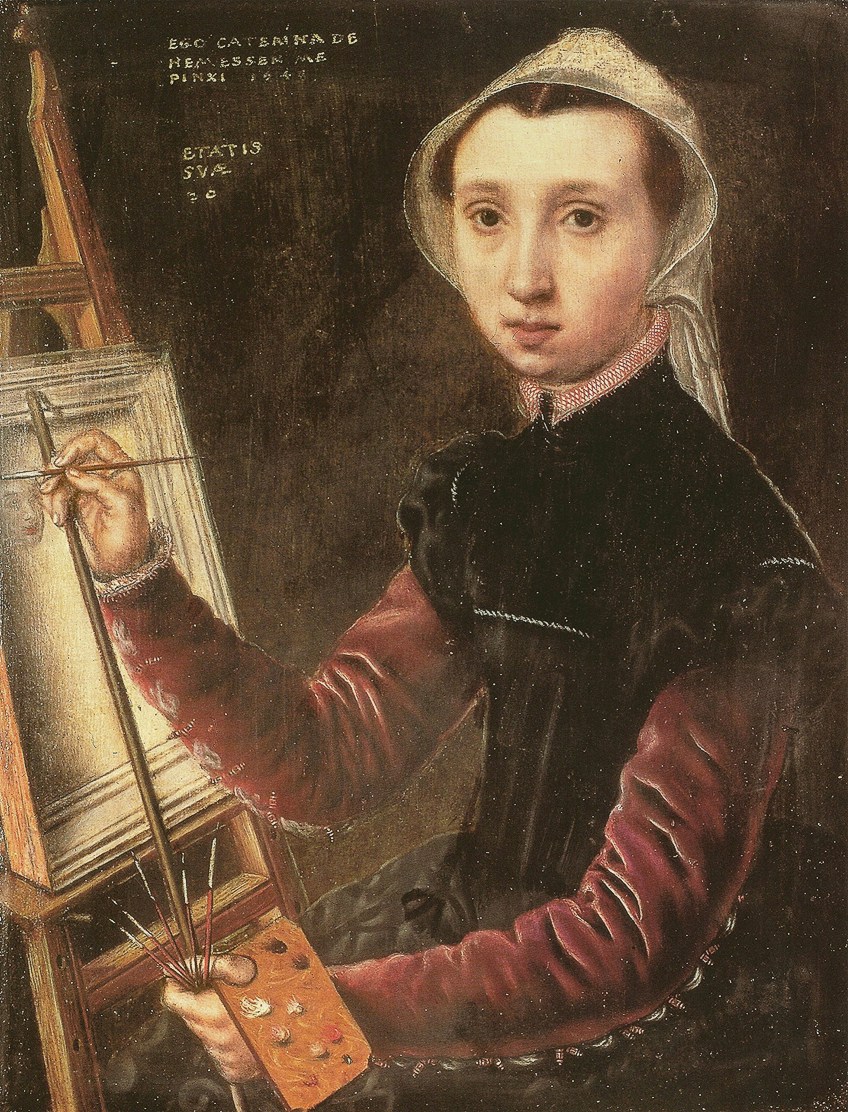
There are a few deliberate contradictions in the portrait as it explores the mirror image. For instance, Hemessen places the sketch of her head on the left side of the panel on the easel, the painting within the painting, whereas in the painting we see the sitter’s head on the right side of the panel.
This suggests that she has taken care to correct the optical inversion created by the mirror she appears to be looking into that sits outside of the frame.
Hemessen’s Self-Portrait gained her considerable acclaim, not only as an illustration of an early modern female self-portrait but also for portraying an artist at an easel. Hemessen was the first artist to do so, it was very atypical for the time to show artists engaging in their everyday life. It was rare for artists to depict the tools they used for their profession. Hemessen’s contribution to Renaissance famous style portraits has shaped our modern perspective of artistic temperament.
Self-Portrait with Bernardino Campi (c. 1559) by Sofonisba Anguissola
| Artist | Sofonisba Anguissola |
| Date Painted | c. 1559 |
| Medium | Oil on canvas |
| Dimensions | 110 cm x 100 cm (before restoration) |
| Where It Is Currently Housed | Pinacoteca Nazionale, Siena, Italy |
A woman of the Renaissance, Sofonisba Anguissola, made a name for herself as one of the first prominent female artists during this period. Anguissola’s sophisticated Self-Portrait with Berardino Campi is a painting within a painting– depicting the artist Bernardino Campi painting a portrait of his student, the young Anguissola. The double portrait is thought to be from the late 1550s when Anguissola would have been in her 20s and it is regarded as an artistic triumph.
Its composition indicates that Anguissola stands outside of the frame, painting her teacher paint her.
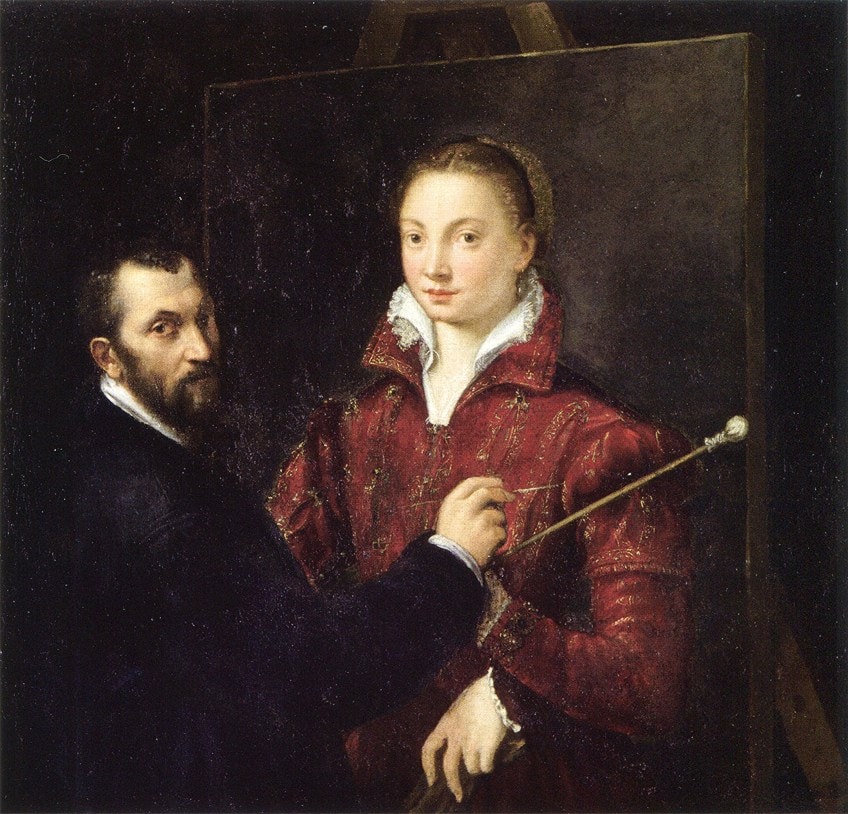
Self-Portrait with Berardino Campi makes her expertise clear to the viewer; her creative artistry is revealed along with her skilled command of the illusion of space; and her ability to emulate in paint expression, flesh, fabric, and texture. Anguissola’s portrayal of both portraits in her painting implies that she was a better artist than her teacher, Berardino.
Anguissola depicts her teacher in a naturalistic manner as he engages the viewer with his gaze, while the painting of Anguissola, which is presumably by her teacher, is stiff and simple.
Anguissola’s immense talents enabled her to triumph over the barriers that she faced on the basis of her gender. She was accomplished beyond an international standard. Anguissola established a place for herself in a field that was otherwise greatly dominated by men, recognized by artists such as Anthony van Dyck and Michelangelo.
Portrait of a Noble Woman (c. 1580) by Lavinia Fontana
| Artist | Lavinia Fontana |
| Date Painted | c. 1580 |
| Medium | Oil on canvas |
| Dimensions | 114.9 cm x 89.5 cm |
| Where It Is Currently Housed | The National Museum of Women in the Arts, Washington D.C., the United States |
Lavinia Fontana is recognized for her magnificent paintings of women, as well as her formidable and exceptional skills as an artist. Fontana’s Portrait of a Noble Woman demonstrates her ability to portray sumptuous jewelry and clothing in remarkable detail. Scholars are convinced that the woman in the portrait was a young Bolognese noblewoman and the painting served as her marriage portrait.
The gems and clothes in the painting correspond with the typical items of a high-born bride, as Bolognese brides would wear red dresses in the 16th-century.

The dark background ensures your focus finds itself on the subject of the painting. Fontana was greatly admired for her depictions of ornamentation and fabric. The pelt of a marten, a mink-like creature, hangs from the bride’s belt as an indication of her wealth, with its head and paws intricately embellished with jewels. The painstaking detail with which Fontana captured major life events for noblewomen, such as the bride in Portrait of a Noble Woman, is what made the nobility of Bologna flock to her, to give them a dignified portrayal of their personhood.
Fontana received training from her father in the field of portraiture and went on to make an impact on the Italian art scene. Recognized for her craft, she garnered fame in Italy and beyond. Fontana made a real career for herself with her art, in fact, she became the first woman in Western Europe who exclusively relied on commissions for the basis of her income.
The 10 most famous Renaissance portraits explored in this article demonstrate the impact and influence the aforementioned artists and their artworks had on the movement itself and those that followed. The artistic contributions from this period were abundant and continue to be celebrated today. These Renaissance art portraits were innovative and inspiring! If our article piqued your interest, browse through our website, we have so many more articles on various art topics that we think you will enjoy!
Also read our renaissance portraits web story.
Frequently Asked Questions
What Are Renaissance Portraits?
Renaissance-style portraits were paintings made between the 15th and 17th centuries, during the Renaissance period. Artists would paint realistic representations of the people who posed for them, not simply recording their features but presenting a vivid depiction of the person before them. It was during the Renaissance that we saw the introduction of the oil painting, which eventually became the standard for artists all over, as opposed to using tempera paint which had been the previous artistic standard. Although Renaissance portrait paintings often depicted people that were of a higher social status, it was during this movement that for the first time in history essentially anyone could get a portrait of themselves done – as long as they could pay for it.
What Makes a Renaissance Portrait?
Renaissance famous portraits focused on realism with their depictions, as they shifted from the Medieval period’s abstract forms. Renaissance art portraits were presenting people in their true form and reflected the development of the Humanist movement. The Ancient Classical fascination with human affairs was reestablished, which highlighted the development of the individual, with portrayals of distinctive likeness. The artworks were not particularly extravagant. In fact, the backgrounds of most Renaissance portraits were quite plain. The subject became the focus of the painting.
Isabella studied at the University of Cape Town in South Africa and graduated with a Bachelor of Arts majoring in English Literature & Language and Psychology. Throughout her undergraduate years, she took Art History as an additional subject and absolutely loved it. Building on from her art history knowledge that began in high school, art has always been a particular area of fascination for her. From learning about artworks previously unknown to her, or sharpening her existing understanding of specific works, the ability to continue learning within this interesting sphere excites her greatly.
Her focal points of interest in art history encompass profiling specific artists and art movements, as it is these areas where she is able to really dig deep into the rich narrative of the art world. Additionally, she particularly enjoys exploring the different artistic styles of the 20th century, as well as the important impact that female artists have had on the development of art history.
Learn more about Isabella Meyer and the Art in Context Team.
Cite this Article
Isabella, Meyer, “Famous Renaissance Portraits – Faces of the Age of Humanism.” Art in Context. January 21, 2022. URL: https://artincontext.org/famous-renaissance-portraits/
Meyer, I. (2022, 21 January). Famous Renaissance Portraits – Faces of the Age of Humanism. Art in Context. https://artincontext.org/famous-renaissance-portraits/
Meyer, Isabella. “Famous Renaissance Portraits – Faces of the Age of Humanism.” Art in Context, January 21, 2022. https://artincontext.org/famous-renaissance-portraits/.







